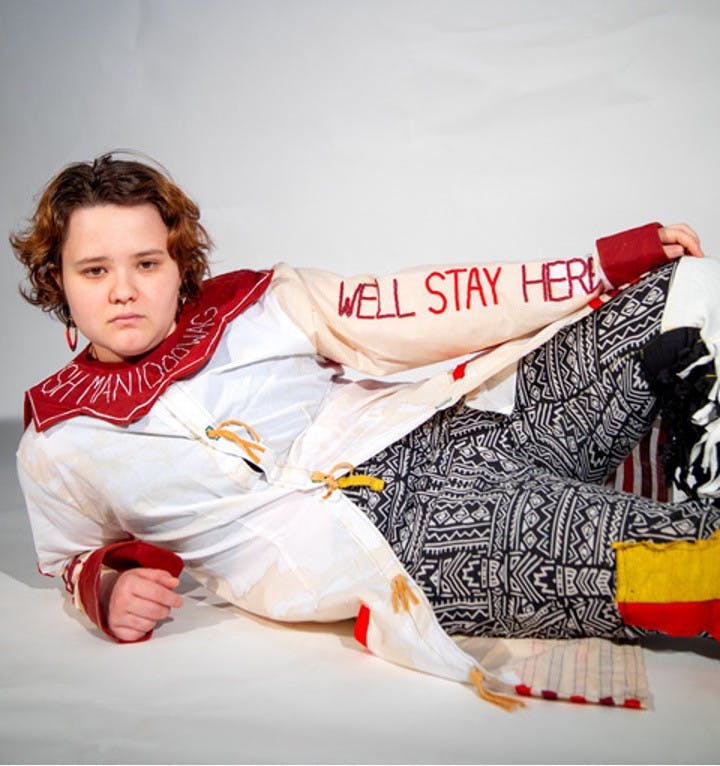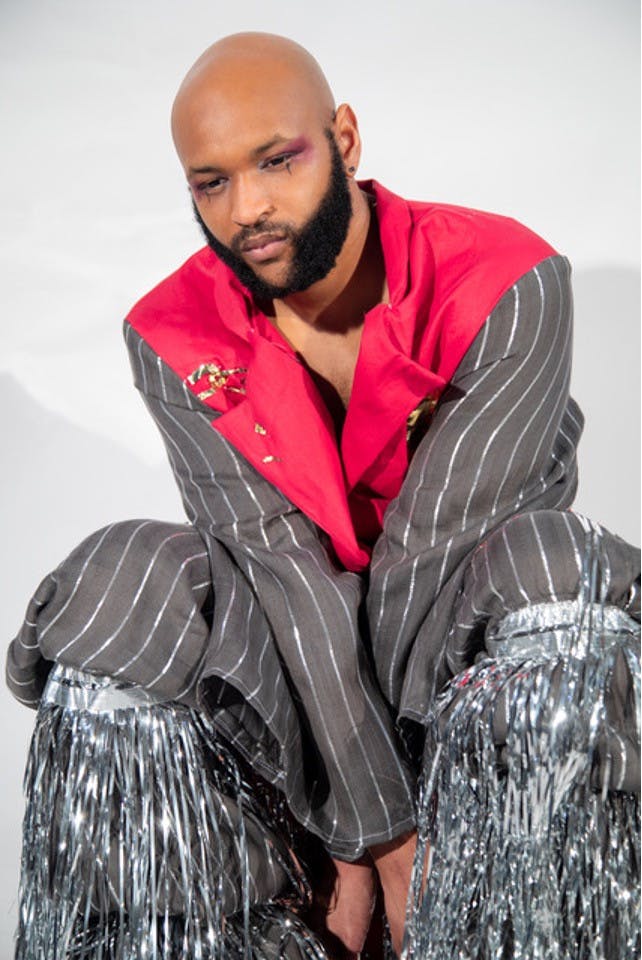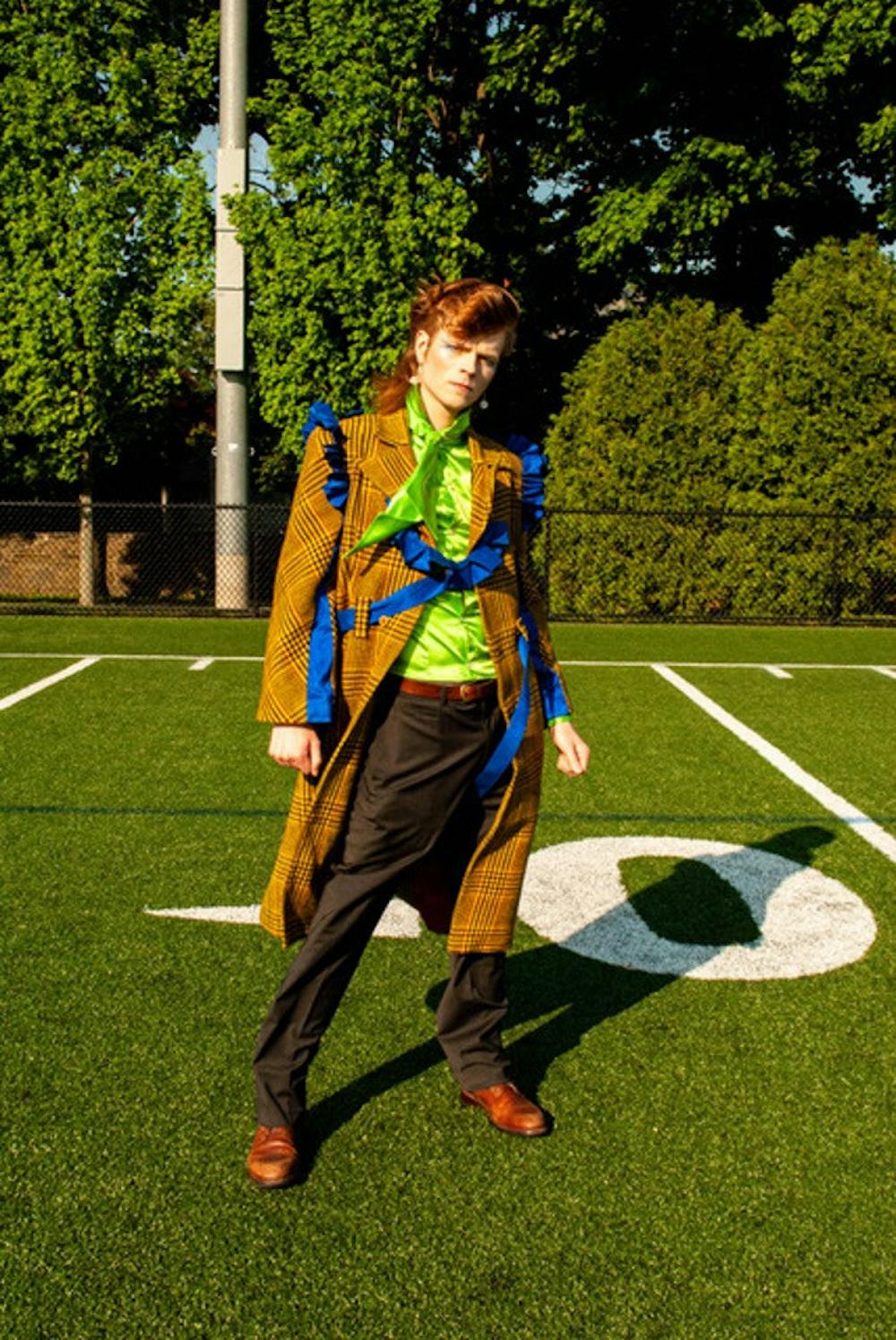In one way or another, Seabass Immonen ’23 has been making art his whole life. And, in one way or another, he has always practiced his own forms of activism. But in the last few years, particularly since he started in the Brown-RISD Dual Degree program, these two sectors of his life have converged.
“I was always creating a lot of art,” Immonen said, “I just didn’t really know what to do with it.”
Now, a quick scroll through Immonen’s Instagram page — dedicated to photos of custom-made garments, modeled and photographed by himself and friends — shows how he has united these interests.
A rising senior in the Rhode Island School of Design’s apparel design program and the University’s international relations concentration, Immomen has found an artistic niche that allows him to blend creation and cause, tackling social issues surrounding queer liberation and social justice through art.
“Queer activism is not really a choice for me. It feels like it’s just what I have to do,” Immonen said. Each garment and collection of his tell an essential story. This is especially exemplified in “Queer Rage,” an activism-focused clothing collection and his latest project for Fashion@Brown, where he works as a design director.
“The collection was designed to create activist pieces with my models. They knew going into it that we were going to be doing statement piece after statement piece,” he said.
For Immomen, collaboration with models has been integral to any design process. But with this collection in particular, it was paramount, he said.
“First and foremost, I want my model to have a really good experience,” he said. “It may not sound like activism, but I’m trying to build community,” he explained.
Immomen noted that building community is at the center of everything he does — a mission his collaborators echoed.
“We’re in a very strange time right now where art is a commodity and we always have to worry about: ‘How is this valuable? How is this thing sold?’ said Laney Day ’23, a dual-degree student. “But I think when Seabass makes a work, it’s not even necessarily about himself — he does it for the people that he’s working with, he does it for his communities.”
Usually, Immonen will sit down with models for an initial interview to go over looks he is considering for them. Then, he asks for their input and dialogue to ensure his vision for the piece aligns with the models’ goals for self-expression. Once the garment is done, he consults the models again on how the work will be publicly displayed.
“It’s a form of creative expression for them that is rare, because no one gets to wear custom clothes super often, and when they’re given the opportunity and radical space to put out whatever message they want, it’s very freeing,” Immonen added. “I would have a model talk about their experiences with biracial identity and bisexual identity and what those nuances are, and together we would create a garment that would catch people’s attention and give them the space to talk about that stuff.”
Among the lineup of collaborators Immonen tapped for “Queer Rage” were former UCS President Jason Carroll ’21 and Day.
For Day’s piece, Immonen was able to craft a garment representative of the intersection of Day’s two-spirit identity and Ojibwe and Cree nationalities. Their working relationship came on the back of an already-existing foundation of friendship, as the pair are going through the Dual Degree program together, Day noted.
“Culture was really important,” Day said. “When I think about rage, a lot of my rage and anger is very directed at and influenced by settler colonialism, imperialism, et cetera. From there, Seabass started to focus specifically on queer people’s relationship to those concepts.”
After their initial interview, Immonen drafted an image board inspired by their conversation, pulling from that selection to make the final outfit, Day explained.
The final piece included many intricate details, such as a VHS tape of the movie “Dances With Wolves” sewn into the pants, which was done to repurpose and reclaim a piece of trope-ridden and derogatory media into a garment centered on queer Indigenous power, they added.

Laney Day ’23, a friend of Immonen, modeled for the artist's "Queer Rage" project.
Courtesy of JaLeel Marques Porcha via Seabass Immonen
“With everything he makes, he has a very specific intention,” Day said. “Nothing is done haphazardly or without care.”
Carroll’s introduction to Immonen’s work differed. After following Immonen on Twitter, Carroll saw one of Immonen’s artist open calls for “Queer Rage” and asked to take part, he said. He added that his design process with Immonen mirrored Day’s.
“Seabass and I had a couple conversations around just who I was, being queer and a Black person — you know, my background, growing up,” Carroll said. The process of working with Immonen, he continued, was an experience that proved not just novel, but empowering.
“Being (UCS) president at the time, I would at least hope (by working with Immonen) that I had the chance to show somebody that you can be involved, you can be politically active, you can have your voice heard, and you can express yourself and have a photo shoot in a dress,” Carroll said.
“If you talk about the broader world of policy, politics, and, even by extension, finance, they’re all very buttoned-up, professionalist type spaces where queerness hasn’t quite had the opportunity to showcase itself,” he said. “As someone going into those fields, it was important for me to be able to say, ‘This is something that a queer person can do. It’s not just some fringe liminal thing. We’re here, and we’re part of society.’”

Jason Carroll ’21, former president of the Undergraduate Council of Students, was also involved in Immonen's "Queer Rage" series.
Courtesy of JaLeel Marques Porcha via Seabass Immonen
Immonen also noted that though his process is involved, it is what is required to create the most thought-provoking and technically advanced garments. In addition to a collaboration process to nail down concepts with models, his designs incorporate “pattern making and customization and serious technical work.”
“The design techniques that I’ve been learning at RISD through the apparel design major have been for sure life changing,” Immonen said. While he said he was a long-time “viewer” of fashion, consistently reading magazines and editorials, it wasn’t until his arrival at RISD that he made the jump to a full-fledged participant in the fashion community.
“There’s a super strong network of queer artists at Brown that connect over friendship more than anything,” Immonen said. “Supporting each other’s work has been so fun, getting to know what everyone’s dreams are and knowing that a lot of these people are going to have such immense creative influence (after) we leave … is a really rare opportunity to practice engaging with community so that when we leave we are able to carry it forward and make something meaningful.”





